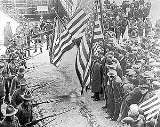
) or labor union (American English
) is an organization of workers that have banded together to achieve common goals such as better working conditions. The trade union, through its leadership, bargains with the employer on behalf of union members (rank and file members) and negotiates labour contracts
(collective bargaining
) with employers. This may include the negotiation of wage
s, work rules, complaint procedures, rules governing hiring, firing and promotion of workers, benefits, workplace safety
and policies.
1648 Boston Shoemakers form first U.S. labor organization.
1834 US President Andrew Jackson orders first use of federal soldiers to suppress a labor dispute.
1834 Six farm labourers from Tolpuddle, Dorset, England are sentenced to be transported to Australia for forming a trade union.
1872 Trade unions are legalised in Canada.
1892 The New Orleans general strike begins, uniting black and white American trade unionists in a successful four-day general strike action for the first time.
1925 The All-China Federation of Trade Unions is officially founded. Today it is the largest trade union in the world, with 134 million members.
1926 UK General Strike 1926: In the United Kingdom, a nine-day general strike by trade unions ends.
1931 Ådalen shootings: five people are killed in Ådalen, Sweden, as soldiers open fire on an unarmed trade union demonstration.
1933 ''Gleichschaltung'': Adolf Hitler bans trade unions.
1936 The Steel Workers Organizing Committee, a trade union, is founded in Pittsburgh, Pennsylvania. Philip Murray is elected its first president.

